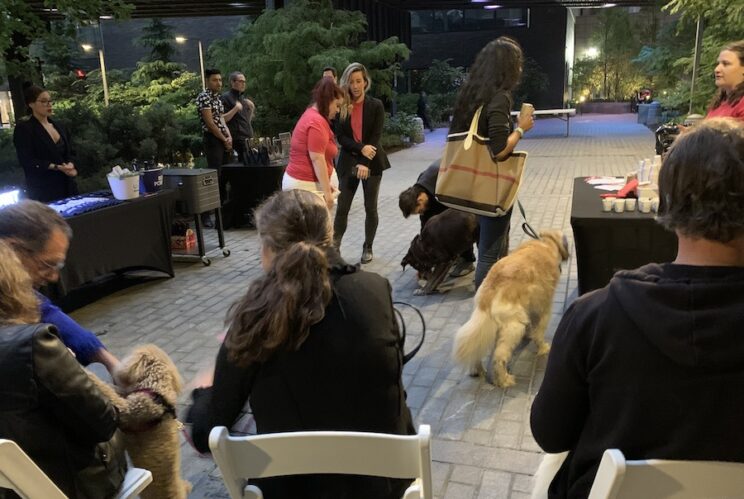
Why Human-Grade Foods are Sweeping the Dog Care Industry
Make no bones about it: people love their pets. The global organic and natural pet food industry, sized at $22.8 billion in 2020, is expected to grow at a compounded rate of 11% annually through 2026.
In part because they are free from pesticides and other chemicals and byproducts, organic and natural pet foods have been shown to boost immunity, reduce allergies, enhance metabolism and improve overall digestive health. One driver of the trend has been humanization, or pet owners treating their dogs as if they were their own children. Now, there is more differentiation in the dog food market than ever. But one company is leading the pack by providing human-grade food for dogs: Ollie.
This unique company teamed up with canine nutritionists to develop cooking methods for a more holistic, healthier and customized approach to dog nutrition. Special, portion-sized packaging keeps the food fresh as it is delivered to your door. Ollie was founded in 2016, on the premise of celebrating every dog’s uniqueness, and the premise that dogs require customized, individualized meals, similar to humans. It is driven by its mission statement, “To known them is to love them.” In the coming year, Ollie will finalize its expansion beyond fresh dog and rebrand as a wellness company.
Here are 10 research-backed reasons why human-grade dog food, like the kind created by Ollie, is integral to dog wellness.
- Helps prevent medical conditions
- Can help keep your dog at a healthy weight.
- Increases your dog’s lifespan
- Improves digestive health
- Helps your dog have better poop
- Higher quality sleep
- Improves cognitive function
- Makes your pup’s coat shiny
- Fuels exercise and helps your pup recover
- Can help your pup overcome picky eating
Dog Training Tips
During a recent speaker series event hosted by Ollie, certified dog trainer Arianna Pomo gave Hudson Yards residents a private dog nutrition and training session. Pomo has 14 years’ experience in canine wellness, with a bachelor’s in animal science and certifications in dog training, puppy raising and dog nutrition.
Keep reading for advice that she gave on a selection of questions raised by residents.
For a dog who was scared to walk through one particular hallway:
If you’re trying to do something scary, new or different, the best way to do it is make the reward a high-value resource. It’s risk/reward for dogs -- you're trying to get them to do something scary, so make sure that reward is strong enough to entice them to take a risk.
To entice her to step into the hallway, I recommend using cheddar for its stronger scent or spreadable cheese on the floor in a fearful spot. It will associate something positive that is happening – they use licking as a natural coping mechanism to calm themselves. Anytime she is in the hallway, say yes and reinforce with treat. She may end up just sitting in the hallway waiting for you.
Freeze dried chicken and beef liver works too, it is less messy but it's dusty. Carrots and green beans are also awesome training snacks to give to dogs. Training treats are good but keep them small, because in a 30-minute session you’re going to be giving 30-40 treats.
For a dog who goes crazy when he hears noise outside:
It sounds like more like fearful behavior than guarding. A lot of times dogs bark to say get away, but why are they saying get away? Because they are nervous about what is outside. This is a more difficult issue because it is not easily predictable. It’s a longer process in training because you have to catch it quickly. In your house, when you hear knocking, give a reward when the dog doesn't make a sound. A knock, an explosion of barking. Wait it out. Once the moment the barking stops, say "YES" and mark it with treat. They are going to make the association, 'oh wait I was quiet and got a treat.'
That will continue until it's one or two barks, then quiet. It's classical conditioning, but it is long process. I would recommend doing this in 15-20-minute periods. During those moments there is a stress level that is skyrocketing for the dog, and that is not a good state to live in because it can actually influence later behavior. Also, dogs do get tired from training and become less receptive.
For a dog who doesn’t like children:
I would not recommend starting him out around kids. Children are tough, because they are erratic and unpredictable in their motions and that scares or confuses dogs. This is going to sound silly , but there is something you can do: get a doll. They have YouTube videos of crying sounds. Put a diaper on the doll with a phone playing the crying sounds and just walk around the house. Go through the motion of sitting with the child, holding the child. Associate familiarity with this new thing.
This is one of the issues I resolved for a client, we had session after session for 2-3 weeks, and then it was OK. The dog understood.
The dog might freaked out by seeing the doll and hearing the sounds, but the moment they are settled, that’s "YES" and a treat Appropriate, curious approach? "YES" and treat. But an aggressive approach, you must stop. When you reach the stage of building comfort with real children outside, always put the dog to the opposite side of the child.
For a dog who has an internal timer on how long to interact with other dogs:
It's socialization, it's his comfort level and it depends on the greeting. Dogs should be greeting each other front to back. For some dogs, face-to-face-greeting is a threat. Dogs are very different than people or primates in general Primates want to make eye contact, if I'm not making eye contact when I'm speaking with you, then you might not trust me. It’s the opposite with dogs. They don’t want to make eye contact. If you make eye contact, that is a threat and a challenge
Any face to face approach is not recommended. I would guide him to do a front to back greeting. And if the other owner is not as aware, then just keep it moving. You don’t want to stress him out because that is a potential risk. Especially if he is providing warning signs like snarling, lip raise, hackle raise, tail.
By the way, a big misconception: A wagging tail does not mean a happy dog. A wagging tail is, "I'm thinking about stuff." There is a lot of research on what the angle of the wag is and what they are thinking about.
The Related Life is written and produced by the Related Life Editorial Team. Be sure to follow us on Facebook and Instagram for the latest events, news and announcements in your area, and tag us for a chance to be featured @therelatedlife and #therelatedlife.
